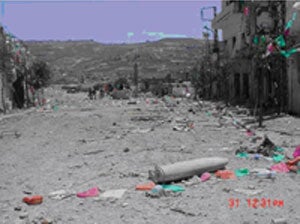Massive amounts of unexploded ordnance (UXO) resulting from 33 days of heavy fighting in Lebanon threaten civilian life and limb, Human Rights Watch said today. These deadly remnants of war, including large air-dropped bombs, artillery shells, missiles and cluster submunitions, pose a danger to displaced civilians returning to southern Lebanon and relief organizations working to distribute humanitarian aid.
Urgent efforts must be made to secure, mark and monitor contaminated areas, and to facilitate plans to clear them as soon as possible, Human Rights Watch said. Both the Israeli military and Hezbollah should share information about target areas and weapons used with local authorities and United Nations agencies whose task it is to protect civilians and humanitarian operations in southern Lebanon from this lethal danger.
“People have just begun to return home and we’re already getting reports of civilians injured,” said Marc Garlasco, senior military analyst at Human Rights Watch. “Unexploded ordnance has turned into a massive problem in southern Lebanon. Now that there is a ceasefire, all parties to the conflict have a duty to help protect the civilian population from these explosive remnants of war.”
Human Rights Watch’s experience working in conflict areas such as Kosovo, Afghanistan and Iraq suggests a real risk that thousands could be killed or maimed if this problem is not urgently dealt with by the warring parties and humanitarian agencies.
Much of the problem is due to the recent Israeli bombing and artillery strikes, which extensively damaged roads, villages and communities in southern, southwestern and eastern areas of Lebanon. Unexploded ordnance now litters these areas. Mine clearance teams are beginning to mark off and clear areas, including sites with unexploded cluster submunitions. To a lesser extent, Hezbollah has also contributed to the problem.

An unexploded aerial bomb on the street of a town in South Lebanon.
© 2006 UN Mine Action Coordination Center for South Lebanon. August 15, 2006.
Human Rights Watch urges parties present in the area to implement all feasible measures to warn persons living or operating in southern Lebanon of this threat and provide for the exclusion of civilians from areas contaminated by unexploded ordnance. Such measures include marking and monitoring affected areas under their control, educating people about the importance of never handling unexploded ordnance, and having all parties to the conflict share information on the types, quantities and locations of weapons used to facilitate clearance.
According to a recent United Nations UXO threat assessment:
- The Israel Defense Forces (IDF) dropped a daily average of 200-300 bombs on areas adjacent to the border, and at least a similar amount on the remainder of southern Lebanon. Coupled with the extensive bombing of areas of southern Beirut and the Bekka Valley, this warfare has left an extensive threat from unexploded high-explosive bombs, including 500 lb., 1,000 lb., and 2,000 lb. weapons;
- The IDF fired a daily average of 200-300 aerial-delivered missiles on areas adjacent to the border, and at least a similar amount on the remainder of southern Lebanon;
- The IDF fired approximately 2,000 artillery rounds per day on areas adjacent to the border, and at least a similar amount on the remainder of southern Lebanon;
- Hezbollah used weapons such as mortars which have a notoriously high dud rate;
- The IDF and Hezbollah engaged in substantial ground combat operations, mainly centered on the villages of Marwahin, Bint Jbeil/Marun al-Ras, Khaim and Kafa Kila/Al Taibe. Both sides extensively used conventional small arms and light missile systems. The IDF targeting of Hezbollah weapons and munitions caches, while destroying many arms, also scattered some munitions in the immediate vicinity.

An unexploded mortar shell burrowed into a road in South Lebanon. The threat from unexploded ground and naval launched artillery will remain a persistent hazard to both humanitarian aid workers and the local population until it is located and destroyed. © 2006 UN Mine Action Coordination Center for South Lebanon. August 15, 2006.
Background
The recent war has exacerbated a longstanding problem with unexploded weapons in Lebanon. Armed forces from several states, including Lebanon, Israel, Syria and the United States, as well as numerous non-state armed groups, extensively used explosive ordnance and landmines at various times from the beginning of the civil war in 1975 until the end of the Israeli occupation of southern Lebanon in 2000. Consequently, antipersonnel mines, antivehicle mines and UXO (including cluster submunitions) can be found throughout the country. In 2004 alone, the Lebanese government and the international donor community gave $13.6 million for landmine and UXO survey, clearance, risk education and survivor assistance. The current conflict has compounded these problems.

An unexploded artillery projectile laying on the ground in a town in South Lebanon.
© 2006 UN Mine Action Coordination Center for South Lebanon. August 15, 2006.
A 2003 national Landmine Impact Survey conducted by the British charity Mines Advisory Group estimated that landmines and/or UXO affected to some degree 22 out of 24 districts in Lebanon, covering a total area of 137 square kilometers. Contamination impeded socioeconomic development and affected more than 30 percent of the country’s population of 3.7 million, the survey said. An estimated 75 percent of the more than 400,000 suspected landmines still in the ground are in the immediate area of the U.N.-delineated Blue Line at Lebanon’s border with Israel, affecting more than 90,000 inhabitants. The remaining 100,000 mines are scattered throughout the rest of the country.
The Landmine Monitor Report 2005 recorded 14 new landmine/UXO casualties in Lebanon in 2004, including two people killed and 12 injured. All of the victims were civilians, including one female and three children under 18 years of age. In June 2005, the Lebanese military stated that 3,975 landmine casualties (1,835 killed and 2,140 injured) had been identified since 1970, with 34 percent of casualties between 31 and 40 years of age. It is essential that the Lebanese population be educated about the expanded risk of UXO in the south of Lebanon and imperative that UXO clearance efforts be put in place immediately.




